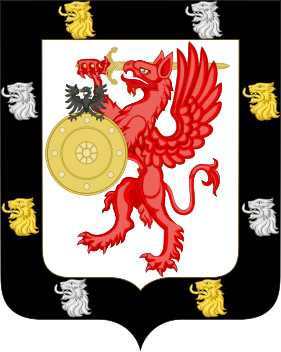 W
WThe House of Romanov was the reigning imperial house of Russia from 1613 to 1917.
 W
WThe Feodorovskaya Icon of the Mother of God, also known as Our Lady of Saint Theodore and the Black Virgin Mary of Russia, is the patron icon of the Romanov family. It is one of the most venerated icons in the Upper Volga region. Her feast days are March 14 (27) and August 29.
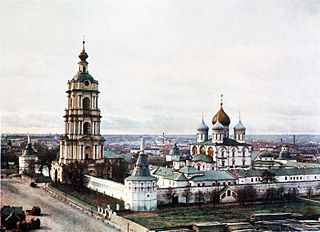 W
WNovospassky Monastery is one of the Russian Orthodox Church fortified monasteries surrounding Moscow from the south-east.
 W
W2013 (MMXIII) was the year of the 400th Anniversary of the founding of the House of Romanov, Russia's Imperial dynasty. At the date of this anniversary, a number of events were organized on the occasion in Russia and Ukraine marking a grand jubilee in their history. The celebration marks the accession of Mikhail Fyodorovich Romanov to the Russian throne on 11 (21) June 1613 beginning a new ruling dynasty of the Romanovs. The rule of dynasty ended with the abdication of Emperor Nicholas II in March 1917. The medal is awarded in three classes: gold, silver and bronze.
 W
WAbdication of Nicholas II was a manifesto of the Emperor of All Russia Nicholas II, signed in Pskov on 3 March (O.S.) / 16 March (N.S.) 1917, in the midst of World War I and the February Revolution. The Emperor renounced the throne of the Russian Empire on behalf of himself and his son, Tsarevich Alexei Nikolaevich, in favor of his brother Grand Duke Michael Alexandrovich. The next day the Grand Duke refused to accept the imperial authority, stating that he would accept it only if that was the consensus of democratic action by the Russian Constituent Assembly, which shall define the form of government for Russia. The rule of the 300 year-old House of Romanov ended with the Grand Duke's decision. After that, power in Russia has passed to the Russian Provisional Government, signaling the victory for the February Revolution.
 W
WThe Alexander Garden Obelisk is an obelisk located within the Alexander Garden, near the walls of Kremlin, in Moscow, Russia. The obelisk was initially designed by S. A. Vlasev and erected on July 10, 1914, at the entrance of the garden. It was created as a celebration of the tercentenary of the House of Romanov. The obelisk was moved closer to the center of the garden in 1966.
 W
WTsarevich Alexei Alexeyevich was the second son and heir of Tsar Alexis of Russia and Maria Miloslavskaya, brother of Tsar Feodor III, Tsar Ivan V, and Tsarevna Sophia and half-brother of Tsar Peter the Great. He died at 15 before he had a chance to succeed to the throne.
 W
WGrand Duke Alexei Petrovich of Russia was a Russian Tsarevich. He was born in Moscow, the son of Tsar Peter I and his first wife, Eudoxia Lopukhina. Alexei despised his father and repeatedly thwarted Peter's plans to raise him as successor to the throne. His brief defection to Austria scandalized the Russian government, leading to harsh repressions against Alexei and his associates. Alexei died after interrogation under torture, and his son Peter Alexeyevich became the new heir apparent.
 W
WAlexei Mikhailovich was the Tsar of Russia from 1645 until his death in 1676. His reign saw wars with Poland and Sweden, schism in the Russian Orthodox Church, and the major Cossack revolt of Stenka Razin. Nevertheless, at the time of his death Russia spanned almost 2,000,000,000 acres (8,100,000 km2).
 W
WGrand Duchess Anastasia Mikhailovna of Russia was the only daughter and second child of Grand Duke Michael Nicolaievich of Russia and a granddaughter of Tsar Nicholas I of Russia.
 W
WAnastasia Romanovna Zakharyina-Yurieva was the first spouse of the Russian Tsar Ivan the Terrible and the first Russian Tsaritsa. She was the mother of Feodor I, the last lineal Rurikid Tsar of Russia and the great-aunt of Michael I of Russia, the first Tsar of the Romanov dynasty. Her parents were Boyar Roman Yurievich Zakharyin, Okolnichi, who died on 16 February 1543, who gave his name to the Romanov dynasty of Russian monarchs, and Uliana Ivanovna, who died in 1579.
 W
WAnna Ioannovna, also spelled Anna Ivanovna and sometimes anglicized as Anne, was regent of the duchy of Courland from 1711 until 1730 and then ruled as Empress of Russia from 1730 to 1740. Much of her administration was defined or heavily influenced by actions set in motion by her uncle, Peter the Great, such as the lavish building projects in St. Petersburg, funding the Russian Academy of Science, and measures which generally favored the nobility, such as the repeal of a primogeniture law in 1730. In the West, Anna's reign was traditionally viewed as a continuation of the transition from the old Muscovy ways to the European court envisioned by Peter the Great. Within Russia, Anna's reign is often referred to as a "dark era".
 W
WGrand Duchess Anna Petrovna of Russia, Tsesarevna of Russia Russian: Анна Петровна; 27 January 1708, in Moscow – 4 March 1728, in Kiel) was the elder daughter of Emperor Peter I, the Great of Russia and his wife Empress Catherine I. Her younger sister, Empress Elizabeth I, ruled between 1741 and 1762. While a potential heir in the reign of her nephew, she never acceded to the throne due to political reasons. However, her son Peter would rule as Emperor in 1762, succeeding Elizabeth. She was the Duchess Consort of Holstein-Gottorp by marriage.
 W
WCatherine I was the second wife of Peter the Great and Empress of Russia from 1725 until her death in 1727.
 W
WTsarevna Catherine Alekseyevna was the fifth daughter of Tsar Alexis of Russia and Maria Miloslavskaya, sister of Tsar Feodor III of Russia and Tsar Ivan V of Russia and half-sister of Tsar Peter the Great.
 W
WTsarevna Catherine Ivanovna of Russia was a daughter of Tsar Ivan V and Praskovia Saltykova, eldest sister of Empress Anna of Russia and niece of Peter the Great. By her marriage, she was a Duchess of Mecklenburg-Schwerin.
 W
WGrand Duchess Catherine Mikhailovna of Russia, was the third of five daughters of Grand Duke Michael Pavlovich of Russia and Princess Charlotte of Württemberg. She was also the wife of Duke Georg August of Mecklenburg-Strelitz.
 W
WCharlotte Christine Sophie also known as Sophie Charlotte or simply Charlotte, was the wife of Tsarevich Alexei Petrovich of Russia. She was the daughter of Louis Rudolph, Duke of Brunswick-Wolfenbüttel and Princess Christine Louise of Oettingen-Oettingen. She was also the great aunt of Queen Marie Antoinette of France.
 W
WAlexandra Feodorovna, born Princess Charlotte of Prussia, was Empress of Russia as the wife of Emperor Nicholas I.
 W
WPrincess Charlotte of Württemberg was later known as Grand Duchess Elena Pavlovna, the wife of Grand Duke Michael Pavlovich of Russia. He was the youngest son of Emperor Paul I of Russia and Duchess Sophie Dorothea of Württemberg.
 W
WTsarevich Dmitry Alexeyevich was the first son and heir of Tsar Alexis of Russia and Maria Miloslavskaya, brother of Tsarevich Alexei Alexeyevich of Russia, Tsar Feodor III of Russia and Tsar Ivan V of Russia and half-brother of Tsar Peter the Great. He died before he had a chance to succeed to the throne. He is buried in the Cathedral of the Archangel.
 W
WGrand Duchess Elena Vladimirovna of Russia, sometimes known as Helen, Helena, Helene, Ellen, Yelena, Hélène, or Eleni, was a Russian grand duchess as the only daughter and youngest child of Grand Duke Vladimir Alexandrovich of Russia and Duchess Marie of Mecklenburg-Schwerin. Her husband was Prince Nicholas of Greece and Denmark and they were both first cousins of Emperor Nicholas II of Russia. She was also first cousin of Queen Juliana of the Netherlands and Alexandrine of Mecklenburg-Schwerin, Queen Consort of Denmark.
 W
WGrand Duchess Elizabeth Mikhailovna of Russia was the second child and daughter of Grand Duke Mikhail Pavlovich of Russia and Princess Charlotte of Württemberg who took the name Elena Pavlovna upon her conversion to the Orthodox faith. Through her father, Elizabeth was a granddaughter of Tsar Paul I of Russia, and a niece of both Russian emperors Alexander I and Nicholas I.
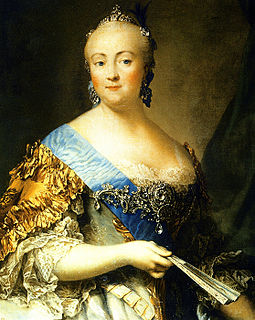 W
WElizabeth Petrovna, also known as Yelisaveta or Elizaveta, was the Empress of Russia from 1741 until her death in 1762. She remains one of the most popular Russian monarchs because of her decision not to execute a single person during her reign, her numerous construction projects, and her strong opposition to Prussian policies.
 W
WThe Russian Imperial Romanov family were shot and bayoneted to death by Communist revolutionaries under Yakov Yurovsky in Yekaterinburg on the night of 16–17 July 1918. Also killed that night were retainers who had accompanied them: notably Eugene Botkin, Anna Demidova, Alexei Trupp and Ivan Kharitonov. The bodies were taken to the Koptyaki forest, where they were stripped and mutilated.
 W
WFeodor III Alexeyevich or Fyodor III Alekseevich was the Tsar of Russia between 1676 and 1682.
 W
WFeodor Nikitich Romanov was a Russian boyar who after temporary disgrace rose to become patriarch of Moscow as Filaret, and became de facto ruler of Russia during the reign of his son, Mikhail Feodorovich.
 W
WPierre Gilliard was a Swiss academic and author, best known as the French language tutor to the five children of Emperor Nicholas II of Russia from 1905 to 1918. In 1921, after the Russian Revolution of 1917, he published a memoir, Thirteen Years at the Russian Court, about his time with the family. In his memoirs, Gilliard described Tsarina Alexandra's torment over her son's haemophilia and her faith in the ability of starets Grigori Rasputin to heal the boy.
 W
WIrina Mikhailovna, was a Russian Tsarevna, the eldest daughter of Tsar Michael of Russia from his second marriage to Eudoxia Streshneva, a noblewoman from Mozhaysk. She was the elder sister of Alexis of Russia.
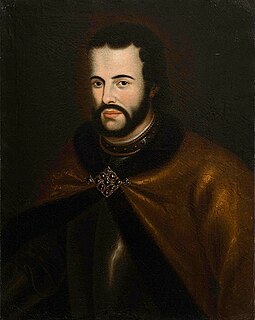 W
WIvan V Alekseyevich was a joint Tsar of Russia who co-reigned between 1682 and 1696. Ivan was the youngest son of Alexis I of Russia by his first wife, Maria Miloslavskaya, while Peter was the only son of Alexis by his second wife, Natalya Naryshkina. Ivan's reign was solely titular because he had serious physical and mental issues.
 W
WGrand Duchess Kira Kirillovna of Russia was the second daughter of Grand Duke Kirill Vladimirovich of Russia and Princess Victoria Melita of Saxe-Coburg and Gotha. She married the head of the German Imperial House, Prince Louis Ferdinand of Prussia.
 W
WAndréi Ivánovich Kobýla was a progenitor of the Romanov dynasty of Russian tsars and many Russian noble families.
 W
WTsarina Eudoxia Feodorovna Lopukhina was a Russian Tsaritsa as the first wife of Peter I of Russia, and the last ethnic Russian and non-foreign wife of a Russian monarch. They married on 27 January 1689 and divorced in 1698 . She was the mother of Tsarevich Alexei Petrovich and the paternal grandmother of Peter II of Russia.
 W
WTsarevna Marfa Alekseyevna of Russia was a Russian princess, daughter of Tsar Alexis of Russia and Maria Miloslavskaya, sister of Tsar Feodor III of Russia and Tsar Ivan V of Russia and half-sister of Tsar Peter the Great. She participated in the rebellion of her sister Sophia against Tsar Peter in 1698, and was therefore imprisoned in a convent. She is an orthodox saint.
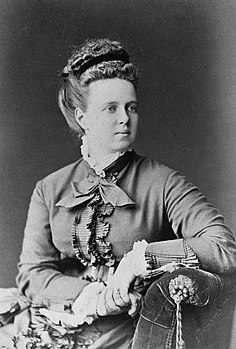 W
WGrand Duchess Maria Alexandrovna of Russia was the fifth child and only surviving daughter of Emperor Alexander II of Russia and his first wife, Princess Marie of Hesse and by Rhine. She was the younger sister of Alexander III of Russia and the paternal aunt of Russia's last emperor, Nicholas II.
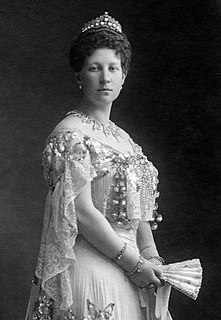 W
WPrincess Maria of Greece and Denmark was a daughter of King George I of Greece and his wife Grand Duchess Olga Constantinovna of Russia. She was a sister of King Constantine I of Greece and a first cousin of Tsar Nicholas II of Russia.
 W
WGrand Duchess Maria Pavlovna "Miechen" of Russia, better known as Maria Pavlovna the Elder, was the eldest daughter of Grand Duke Frederick Francis II of Mecklenburg-Schwerin by his first wife, Princess Augusta Reuss of Köstritz. A prominent hostess in St Petersburg following her marriage to the Grand Duke Vladimir Alexandrovich of Russia, she was known as the "grandest of the grand duchesses" and had an open rivalry with her sister-in-law the Empress Maria Feodorovna.
 W
WMichael I became the first Russian Tsar of the House of Romanov after the zemskiy sobor of 1613 elected him to rule the Tsardom of Russia. He was the son of Feodor Nikitich Romanov and of Xenia. He was also a first cousin once removed of the last Rurikid Tsar Feodor I through his great-aunt Anastasia Romanovna, who was the mother of Feodor I, and through marriage, a great-nephew in-law with Tsar Ivan IV of Russia. His accession marked the end of the Time of Troubles. During his reign, Russia conquered most of Siberia, largely with the help of the Cossacks and the Stroganov family. Russia had extended to the Pacific Ocean by the end of Michael's reign.
 W
WNatalya Kirillovna Naryshkina was the Tsaritsa of Russia from 1671–1676 as the second spouse of Tsar Alexis I of Russia, and regent of Russia as the mother of Tsar Peter I of Russia in 1682.
 W
WGrand Duchess Natalia Petrovna of Russia was the youngest daughter of Peter the Great and his second wife, Catherine I.
 W
WGrand Duchess Natalya Alexeyevna of Russia was a Russian Grand Duchess. She was the elder sister of Emperor Peter II of Russia, a maternal first cousin of Holy Roman Empress Maria Theresa I, and Charles I, Duke of Brunswick-Wolfenbüttel. She was also a paternal first cousin of Peter III of Russia.
 W
WTsarevna Natalya Alexeyevna of Russia was a Russian playwright. She was the elder daughter of Tsar Alexis and his second wife, Natalia Naryshkina, and the sister of Peter the Great.
 W
WNicholas II or Nikolai II Alexandrovich Romanov, known in the Russian Orthodox Church as Saint Nicholas the Passion-Bearer, was the last Emperor of All Russia, ruling from November 1894 until his abdication in March 1917. During his reign, Russia embarked on a series of reforms including the introduction of civil liberties, literacy programs, state representation, and initiatives to modernize the empire's infrastructure. Ultimately, this progress was undermined by Nicholas's commitment to autocratic rule, oppressive policies pursued by his regime, and crushing defeats sustained by the Russian military in the Russo-Japanese War and World War I. By March 1917, public support for Nicholas collapsed and he was forced to abdicate, thereby ending the Romanov dynasty's 300-year rule of Russia. In the years following his abdication, Nicholas was reviled by Soviet historians and state propaganda as a callous tyrant who persecuted his own people while sending countless soldiers to their deaths in pointless conflicts. More recent assessments have characterized him as a well-intentioned, hardworking ruler who proved incapable of handling the challenges facing his nation.
 W
WGrand Duke Nicholas Nikolaevich of Russia was the third son and sixth child of Tsar Nicholas I of Russia and Alexandra Feodorovna. He may also be referred to as Nicholas Nikolaevich the Elder to tell him apart from his son, Grand Duke Nicholas Nikolaevich of Russia (1856–1929). Trained for the military, as a Field Marshal he commanded the Russian army of the Danube in the Russo-Turkish War, 1877–1878.
 W
WGrand Duchess Olga Pavlovna of Russia was a Grand Duchess of Russia as the second youngest daughter and seventh child of Emperor Paul I of Russia and his empress consort, Sophie Dorothea of Württemberg.
 W
WOlga Constantinovna of Russia was Queen consort of the Hellenes as the wife of King George I. She was briefly the regent of Greece in 1920.
 W
WPeter the Great, Peter I or Pyotr Alekseevich ruled the Tsardom of Russia and later the Russian Empire from 7 May [O.S. 27 April] 1682 until his death in 1725, jointly ruling before 1696 with his elder half-brother, Ivan V.
 W
WPeter II Alexeyevich reigned as Emperor of Russia from 1727 until his untimely death. He was the only son of Tsarevich Alexei Petrovich and of Charlotte Christine of Brunswick-Lüneburg.
 W
WPraskovia Fyodorovna Saltykova was the tsaritsa of Russia as the only wife of Ivan V of Russia. She was the mother of Empress Anna of Russia. She played an important part as the most senior woman of the Russian court in 1698–1712.
 W
WPraskovya Ivanovna (1694–1731) was a Russian tsarevna, daughter of Tsar Ivan V of Russia and Praskovia Saltykova. She was the niece of Tsar Peter the Great and the sister of Empress Anna Ivanovna.
 W
WThe Romanov Prophecy is a 2004 novel written by Steve Berry and is an amalgam of fact and fiction. The novel relates the adventures of Miles Lord, an African-American lawyer in post-communist Russia on finding the descendants of Grand Duchess Anastasia Nikolaevna of Russia and Tsarevich Alexei of Russia, who were thought to survive the massacre that took their family's lives.
 W
WThe canonization of the Romanovs was the elevation to sainthood of the last Imperial Family of Russia – Tsar Nicholas II, his wife Tsarina Alexandra, and their five children Olga, Tatiana, Maria, Anastasia, and Alexei – by the Russian Orthodox Church. The family was killed by the Bolsheviks on 17 July 1918 at the Ipatiev House in Yekaterinburg. The house was later demolished. The Church on Blood was built on this site, and the altar stands over the execution site.
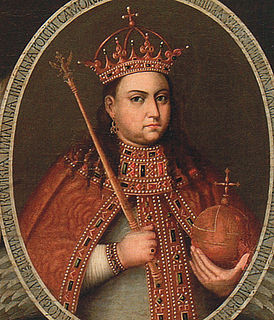 W
WSophia Alekseyevna ruled as regent of Russia from 1682 to 1689. She allied herself with a singularly capable courtier and politician, Prince Vasily Golitsyn, to install herself during the minority of her brother Ivan V and half-brother Peter I. She carried out her regency with a firm hand. The activity of this "bogatyr-tsarevna" was all the more extraordinary, as upper-class Muscovite women, confined to the upper-floor terem and veiled and guarded in public, invariably were kept aloof from any open involvement in politics.
 W
WBoyarinya Kseniya Ioannovna (Ivanovna) Shestova was a spouse of Fyodor Romanov and the mother of Mikhail Romanov.
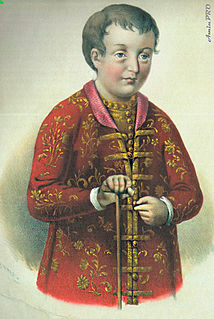 W
WTsarevich Simeon Alexeyevich was the fourth of Tsar Alexis of Russia and Maria Miloslavskaya, brother of Tsar Feodor III of Russia and Tsar Ivan V of Russia and half-brother of Tsar Peter the Great. He died young.
 W
WEudoxia Streshnyova was the Tsaritsa of Russia as the second spouse of Tsar Michael of Russia.
 W
WPrincess Tatiana Konstantinovna of Russia was the third child and oldest daughter of Grand Duke Konstantin Konstantinovich of Russia and wife, Princess Elisabeth of Saxe-Altenburg.
Princess Vera Constantinovna of Russia, also Vera Konstantinovna, was the youngest child of Grand Duke Konstantine Konstantinovich of Russia and his wife, Grand Duchess Elizabeth Mavrikievna. A great-granddaughter of Tsar Nicholas I of Russia, she was born in the Russian Empire and was a childhood playmate of the younger children of Emperor Nicholas II of Russia. She lost much of her family during World War I and the Russian Revolution. At age twelve, she escaped revolutionary Russia, fleeing with her mother and brother George to Sweden. She spent the rest of her long life in exile, first in Western Europe and from the 1950s in the United States.
 W
WPrincess Xenia Georgievna of Russia was the younger daughter of Grand Duke George Mihailovich of Russia and Princess Maria Georgievna of Greece and Denmark. She is known for recognizing Anna Anderson as Grand Duchess Anastasia.